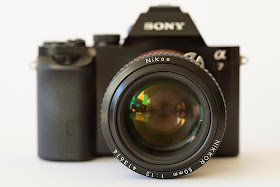I recently purchased a Mitakon 50mm f/0.95 in the hope it would produce some impressive subject isolation. Despite being relatively inexpensive it did deliver in some areas. It was amazingly sharp, but didn't impress me with its bokeh aesthetics or haze. Given it's immense weight (>800g), I shifted my attention towards older lenses. Something lighter, smaller and cheaper. Since I also have a full-frame Nikon DSLR in the house this 50mm f/1.2 AI-S Nikkor lens seemed the most logical choice
Stats
Focal Length / Angle: 50mm / 46°
Aperture range (f stop): 1.2 - 16
Construction: 7 elements in 6 groups
Aperture Blades: 9 (rounded)
Minimum Focus Distance: 50cm
Max Reproduction Ratio: 1/6.8
Dimensions: 69x48mm
Weight: 359g
DoF Scale: Good
Filter Size: 52mm
Physical Aperture Ring: Yes
Focus Mechanism: Manual
Focus Ring: Attached
Body/filter Material: Metal / Metal
Made In: Japan
Price (New/SH): £850 / £300 (rough)
Scores (general)
Center sharpness: 8/10
Corner sharpness: 7/10
Distortion: 8/10 (Fairly low)
Bokeh quality: 7/10
CA (Chromic Aberration): 5/10
Coma Fringing: 3/10
Haze: 1/10
Flare: 7/10
IR - Flare: 7/10 (No worse than colour)
IR - Hotspot: 9/10 (slight @ f/16)
IR - Colour Separation: 9/10 (Minimal)
IR - Focus offset marker: 10/10 (Yes)
Bokeh & Distance Focusing
Most of these super fast lenses produce great sharpness when shooting very close and wide open, but when the focal point is a bit further away (>2m) then a haze creeps into the image and it gets worse the further away you focus (even when the focus accuracy is perfect). This does not mean your lens is broken. Most 50mm f/1.2 lenses exhibit this (accept the Nikon NOCT lens), but it's worth noting that this lens is unfortunately one of the worst for it.
Infra-red Issues
This lens is quite a legend, much has already been written about it so I will concentrate this review on it's application for infra-red. All of this lenses qualities shine through in IR, just as they do with colour. That includes sharpness as well as distance haze when shooting wide open. Flare is similarly well controlled and not much of an issue unless shooting directly into the sun, but again, this is the same story with colour shots and even then it's not horrible. Infra-red Issues
If you've read the 'cons' above you'll know that this lens does technical suffer from the IR hotspot issue, but it was so minimal I really struggled to get it to show up. Only at minimum aperture (f/16) could I get it and even then it was only through pushing the contrast up really high. In general use I don't think this will cause a problem, but it's worth knowing that it is there.
Infra-red Samples
These samples are taken with using the Heliopan RG780. I like this filter because it provides an almost identical exposure to visible light (colour), while giving an almost pure IR, relatively high contrast result. As long as the lighting is good (not thick cloud) then this gave me very clean noise free images because they didn't need boosting too much.
Pros (higher is better)
- Fits any Nikon body, plus easily adaptable to Sony & Canon (9/10)
- Stunning focus feedback (9/10)
- Stunning build quality (9/10)
- Sharpness and minimal aberrations @ f/2 (8/10)
- Minor issues with IR shooting (7/10)
- Bokeh Aesthetics (7/10)
- Aperture ring is all in full stops and clicks beautifully (7/10)
- Great relative sharpness and overall when stopped down (9/10)
- Small and quite light for a metal f/1.2 lens (7/10)
- IR offset focus marker (6/10)
- Great colours and low lens flare (6/10)
- 52mm filter thread is great for such a wide aperture (6/10)
Cons (higher is worse)
- Veil Haze - focusing beyond 2m below f/2 (9/10)
- New price is crazy, second hand isn't low either (8/10)
- Coma fringing is annoying but common, even on expensive lenses (2/10)
- No AF version available (2/10)
- Discontinued, although easily available (1/10)
Overall Score:
9/10
Everyone should have a 50mm lens. This is a really great one and apart from it's insanely expensive brother (the 58mm NOCT) it's one of the best Nikon ever made. Although some people report this to have IR hotpot at f/5.6 and beyond I could only barely see it at f/16, so unless I got an odd sample I'd say it's not something that should put IR shooters off buying this lens at all.
All the colour samples from this lens below are taken using a 'Kolari Vision Hot Mirror'.

example of haze from the lens wide open and the focal point at around 2-3m
.jpg)
f/5.6 - Feb 3rd 2015 on Hampstead Heath (possibly our only snow of the year)

f/1.2 @ roughly 2m distance (slightly hazy)
Bokeh Panorama Samples:
This technique involves taking a bank of photos at (or close to) the widest aperture, while rotating the camera on the lenses entrance pupil. These are then stitched together to make a larger, wider angle photo with shallow depth-of-field. On longer focal length lenses I usually take about 30-40 images for each panorama, but for a 50mm lens you don't need as many and if you try more it often ends with horrific distortion. To capture these results in a single frame would require a lens in the region of a 20mm f/0.6, If it existed a lens like this would be too large, heavy and expensive to warrant using and/or buying. It would also be extremely difficult to make it perform to the same quality that can be obtained using this method. The down side of this method is that it requires a relatively still subject.









Infra-Edd: Lens Review - Nikkor 50Mm F/1.2 Ai-S >>>>> Download Now
ReplyDelete>>>>> Download Full
Infra-Edd: Lens Review - Nikkor 50Mm F/1.2 Ai-S >>>>> Download LINK
>>>>> Download Now
Infra-Edd: Lens Review - Nikkor 50Mm F/1.2 Ai-S >>>>> Download Full
>>>>> Download LINK EZ